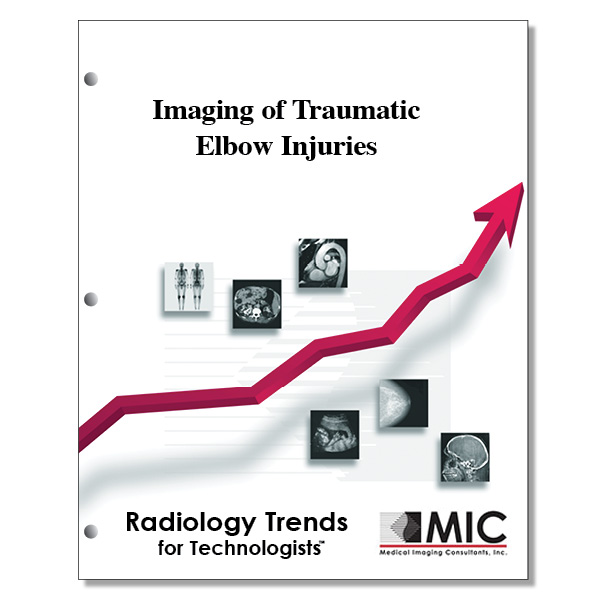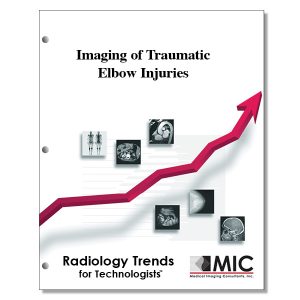

Imaging of Traumatic Elbow Injuries
Common traumatic elbow injuries are studied and clinically relevant image findings are presented.
Course ID: Q00398 Category: Radiology Trends for Technologists Modalities: MRI, Nuclear Medicine, Radiography3.5 |
Satisfaction Guarantee |
$37.00
- Targeted CE
- Outline
- Objectives
Targeted CE per ARRT’s Discipline, Category, and Subcategory classification for enrollments starting after April 6, 2023:
[Note: Discipline-specific Targeted CE credits may be less than the total Category A credits approved for this course.]
Computed Tomography: 2.25
Procedures: 2.25
Head, Spine, and Musculoskeletal: 2.25
Magnetic Resonance Imaging: 3.50
Patient Care: 1.25
Patient Interactions and Management: 1.25
Procedures: 2.25
Musculoskeletal: 2.25
Nuclear Medicine Technology: 1.25
Patient Care: 1.25
Patient Interactions and Management: 1.25
Radiography: 3.50
Patient Care: 1.25
Patient Interactions and Management: 1.25
Procedures: 2.25
Extremity Procedures: 2.25
Registered Radiologist Assistant: 3.50
Patient Care: 1.25
Patient Management: 1.25
Procedures: 2.25
Musculoskeletal and Endocrine Sections: 2.25
Sonography: 1.25
Patient Care: 1.25
Patient Interactions and Management: 1.25
Outline
- Introduction
- Functional Anatomy of the Elbow
- Elbow Instability
- Common Injury Patterns
- Radial Head and Neck Fractures
- Essex-Lopresti Fracture-Dislocation
- Distal Humerus Fracture
- Coronoid Process Fracture
- Olecranon Fracture
- Elbow Dislocation
- Terrible Triad
- Monteggia Fracture and Dislocation
- Conclusion
Objectives
Upon completion of this course, students will:
- know what percentage of emergency room visits in the United State are for elbow injuries
- define the acronym FOOSH
- understand the findings a radiologist conveys to the surgeon or clinician when interpreting elbow trauma images
- know the names of the bones that make up the forearm and elbow region
- define the various articulations that make up the elbow joint
- be familiar with the joint classification of the elbow joint
- be able to name the various elbow joint fat pads
- understand which of the elbow joint articulations control pronation, supination, flexion, and extension
- describe what bundles make up the medial collateral ligament complex of the elbow joint
- describe the bundles that make up the lateral collateral ligament complex of the elbow joint
- know which of the ligaments the primary stabilizers of the elbow joint are
- explain which of the elbow joint ligaments provide stability to valgus and varus forces
- be familiar with the major blood vessels associated with the elbow joint
- know the major muscles associated with the elbow joint
- understand which fractures in the elbow could cause blood vessel damage
- understand how elbow joint dislocations rank in frequency in comparison with other joints
- describe what elbow dislocation complications concern orthopedic surgeons
- describe how elbow joint dislocations are classified
- know what potential complications may arise from elbow dislocations
- be familiar with dynamic radiography and its role in the diagnosis of medial collateral ligament insufficiency
- know which imaging modalities are used to in the diagnosis of elbow ligament damage
- know which imaging modality is used for identifying associated occult coronoid or radial head fractures for patients with posterolateral rotatory instability of the elbow
- know which type of fracture is the most common in children
- know the various positions an elbow joint is normally in and how trauma or injury may change that
- describe the elbow anatomy seen using routine radiography views
- describe the Jones Method
- describe the Coyle Method
- be familiar with the radiographic lines seen in elbow radiography
- describe fracture considerations that apply to radial head and neck fractures of the elbow
- know what the Mason-Johnston system classification for radial head and neck fractures is
- be familiar with how casts affect radiographic exposure techniques
- describe what an Essex-Lopresti injury of the elbow is
- describe the types of distal humeral fractures and the various classification systems for them
- describe the classification systems describing coronoid process fractures of the elbow
- know the ramifications an olecranon process fracture may present
- describe the various types of elbow dislocations
- describe the type of fracture represented by a “terrible triad” type of injury to the elbow
- describe what additional imaging modalities may supplement conventional radiography with a “terrible triad” injury
- describe the type of fracture represented by a Monteggia fracture-dislocation injury
- describe the classification systems of a Monteggia fracture-dislocation injury
